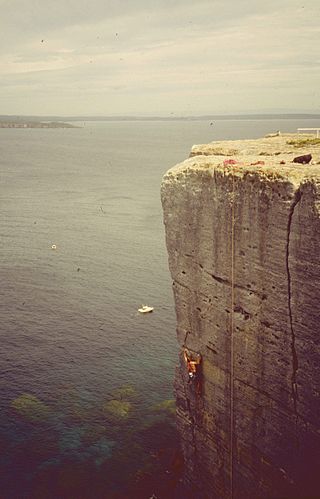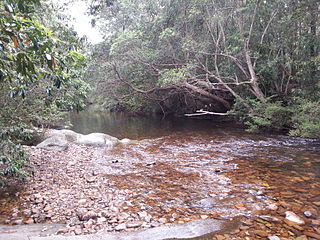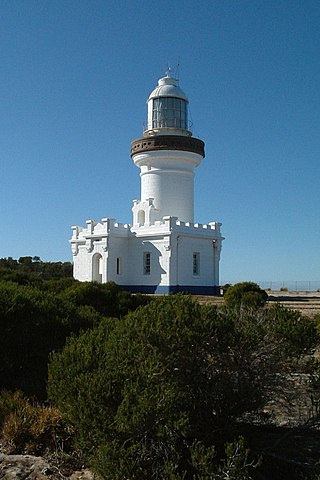
Booderee National Park and Botanic Gardens, formerly Jervis Bay National Park and Jervis Bay Botanic Gardens, are located in the Jervis Bay Territory of Australia. The reserve is composed of two sections:

Jervis Bay is a 102-square-kilometre (39 sq mi) Oceanic bay and village in the Jervis Bay Territory (ACT) and on the South Coast of New South Wales, Australia.

The Clyde River is an open intermediate tide-dominated drowned valley estuary or perennial river that flows into the Tasman Sea at Batemans Bay, located in the South Coast region of New South Wales, Australia.

Jervis Bay Nuclear Power Plant was a proposed nuclear power reactor in the Jervis Bay Territory on the south coast of New South Wales. It would have been Australia's first nuclear power plant, and was the only proposal to have received serious consideration as of May 2023. Some environmental studies and site works were completed, and two rounds of tenders were called and evaluated, but the Australian government decided not to proceed with the project.

Beecroft Peninsula is the northern headland of Jervis Bay, on Australia's east coast. On the western and southern sides of the peninsula steep sandstone cliffs rise out of the ocean, up to 91 metres at its southernmost point, Point Perpendicular. White sandy beaches are found along the northern, eastern and southern sides interspersed with numerous intertidal reefs.

Hyams Beach is a seaside village in the City of Shoalhaven, New South Wales, Australia, on the shores of Jervis Bay. At the 2016 census, it had a population of 112. The village, 180 km south of Sydney, is bordered by two beaches, Chinaman's Beach to the north and Seaman's Beach to the south, with Hyams Beach being in the centre. A seaside resort, its beach is known for having turquoise/aqua-coloured waters and fine, squeaky, brilliantly white sand composed of pure quartz.

Jervis Bay Village is a village in the Jervis Bay Territory, Australia. HMAS Creswell Royal Australian Navy base is located in the town. Apart from the navy base there is an Aboriginal community in the town. It is the largest town in the Jervis Bay Territory, with 189 inhabitants.

Callala Bay is a small town on the South Coast of New South Wales, Australia in the City of Shoalhaven.

Cape St George Lighthouse was a lighthouse that stood near Jervis Bay Village, Jervis Bay Territory, Australia. It was located about 3 kilometres (1.9 mi) south of the southern entrance to Jervis Bay. Constructed in 1860 it was active until 1889. The tower was destroyed between 1917–1922 to avoid confusion in daylight. The ruins remain and are listed on the Commonwealth Heritage List.

The Parish of Bherwerre is a parish of the County of St Vincent in New South Wales which formerly included the area that is now the Jervis Bay Territory, which was transferred to the Commonwealth of Australia in 1915. Because of this, the parish is now less than half the size it was in the nineteenth century. The Jervis Bay Territory Acceptance Act of 1915 mentions that 18,000 acres (7,300 ha) of the parish were transferred to the Commonwealth. The Seat of Government Acceptance Act of 1909 mentions that three separate parcels in the parish were planned to be transferred to the Commonwealth from Bherwerre, along with land in other nearby parishes, although the actual land transfer in 1915 was only made up of land in the Parish of Bherwerre. The land mentioned in the 1909 act was a 2-square-mile (5.2 km2) portion, a 412-acre (167 ha) portion, and the 132 acres (53 ha) of Bowen Island. At the time, the parish was located in Clyde Shire.
Nancy was a sloop launched in 1803 and wrecked on 18 April 1805 near Jervis Bay, Australia.

Currarong is a small coastal fishing and tourist village of 556 houses in the Shoalhaven area of New South Wales, Australia. At the 2021 census, Currarong had a permanent population of 479. The village is a haven for fishermen, with several underwater rises where fish are abundant. As of 2021, there is a general store and take away cafe called Zac's Place, a licensed club, a caravan park, and many properties available for holiday rental.

Yadboro River, a perennial river of the Clyde River catchment, is located in the Southern Tablelands and the upper ranges of the South Coast regions of New South Wales, Australia.
Aeolus was a wooden ketch built in 1850 at Pyrmont, New South Wales, Australia. She was carrying timber to Sydney, New South Wales, when she was lost at Hole in the Wall, Jervis Bay, New South Wales, on 24 October 1867. The wreck has not been located, but its approximate position is 35.134648°S 150.745874°E.
Agnes was a wooden carvel ketch built in 1877 at Williams River, Eagleton, near Newcastle, New South Wales, Australia. She was wrecked when she foundered off Jervis Bay, New South Wales, in 1883.

Point Perpendicular Light is a lighthouse located on Point Perpendicular, a point at the southern tip of the Beecroft Peninsula, in New South Wales, Australia. It marks and the northern entrance to Jervis Bay. The historic lighthouse was active from 1889 to 1993 and is still present, though its future is unclear. It is believed to be the first lighthouse in New South Wales which was built of precast concrete blocks. The light was replaced in 1993 with a skeletal tower which is active.

The Barrenjoey Head Lighthouse is a heritage-listed lighthouse at Barrenjoey Headland, Palm Beach, Northern Beaches Council in Sydney, New South Wales, Australia. It was designed by James Barnet, the New South Wales Colonial Architect and built by Isaac Banks. It is also known as Barrenjoey Head Lightstation. The property is owned by Office of Environment and Heritage, an agency of the Government of New South Wales. The lightstation was added to the New South Wales State Heritage Register on 2 April 1999.
Wandra was a wooden twin screw steamer built in 1907, for Allen Taylor & Company, by Denis Sullivan at Coopernook, New South Wales. Her hull was towed to Sydney for her engines to be fitted by Begg and Greig.













